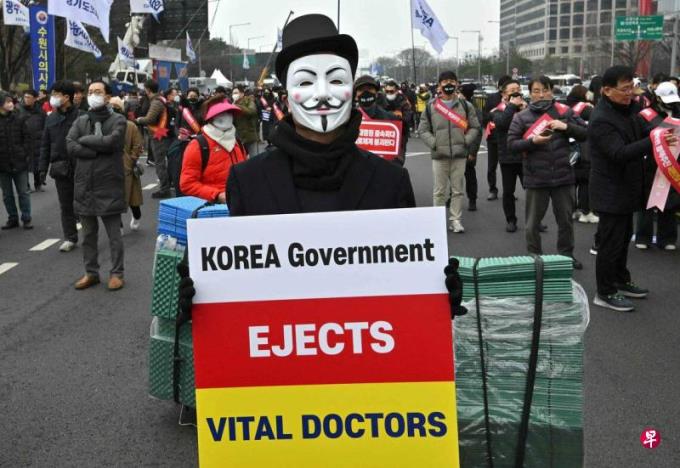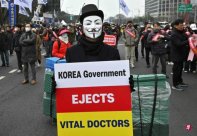
Singapore seems to be right in many ways, and the biggest difference from the United States and South Korea, maybe it is not to be dominated by the market, but the government -led.In terms of medical problems, each country has different national conditions and has a difficult scripture, so each has its own beliefs and practices.As for whether the medical system is good or not, it will be effective in the end.
The South Korean government announced in early February that since the 2025 school year, the recruitment quota of the medical school has increased by 65%, about 2,000 people, from the current 3058 people to 5058 people each year.The move immediately caused more than 9,000 internships and inpatients from various hospitals to oppose it and took a strike to protest.On March 3, 10,000 people stepped onto the street demonstration.In addition to the strike doctor, the participants also include the chief doctor, doctors of private hospitals, and students of medical schools.
Many people don't understand why.The government decided to expand the reasons. The reason for. The number of doctors was not enough to cope with the rapid aging population. It is estimated that by 2035, the doctor's gap will be as high as 15,000.Therefore, 2,000 people are expanded each year, and about 10,000 people can be added in five to 10 years, and the remaining 5,000 will be supplemented by returning to retired doctors.The strike doctor said that this cannot solve the problem. Expansion will only affect their work treatment. They are currently under pressure and low salary. Multi -enrollment is equivalent to bringing them more intense competition.
Comprehensive reports of all parties, the problem of the problem seems to be the entire medical system in South Korea.The Korean medical system is mainly maintained by private hospitals.According to reports, Korean private medical institutions account for 95%of the total, and public hospitals account for only about 5%of the total, and high -quality medical resources are highly concentrated near the capital Seoul.That is to say, the Korean medical system mainly depends on the market.This may follow the theory of the New Liberal Economy School in the United States, and I believe that the market can solve all problems.
But from a national perspective, medical services are basically public services and are public products that the government should provide.Having 95%of the task to private hospitals is responsible, thinking that through competition, it can lower the charges and provide the people with the most effective and cheapest medical services for the people. This is really naive.
One of the nature of the market is of course free competition, but the more important essence is profit.Capitalists invest in hospitals, and they are also making money, not doing good.When the market is completely or almost dominated by capital, it may indeed cause fierce competition.However, capitalists are not idiots. They will seek countermeasures. First of all, they will increase their capacity by increasing the volume and greater market share, and thereby increasing their ability to dominate the market. Secondly, try to reduce costs as much as possible.
South Korea's intern may be the victim of this market -led medical system.They must pass the internship to become a practicing doctor, and therefore cannot avoid being exploited and become cheap workers.Since more than 90 % of hospitals are private hospitals, the treatment of intern is actually in the hands of private hospitals.In order to safeguard its own interests, the private hospitals will not be associated with the compensation of the intern.
It is reported that the five major hospitals in Seoul (the Affiliated Hospital of Seoul University, Shifangs Hospital of Yanshi University, Samsung Seoul Hospital, Seoul Eshan Hospital, and Seoul's Our Lother Hospital) all hired a large number of intern doctors, accounting for the four doctors of these hospitalsbecome.This may be one of the ways to reduce costs.In this case, if the supply of doctors continues to increase, it is equivalent to providing more "cheap workers" for private hospitals in the future.In this case, the treatment of the intern is unparalleled.Therefore, they are also understandable.
This should be said to be a system or structural problem. Unless changing the system, it is difficult to touch the essence of the problem.This problem is actually brewing fermentation in the new liberal home.The 2015 Nobel Prize winner of the Economics Angus Deaton, published in 2020, died in the book of Deaths of Despair and the Future of Capitalism, which was published.The disadvantages of the US medical system are discussed in detail.
The author pointed out that the American medical industry is a cancer tumor in the heart of the economy and has spread in large areas.The medical system spends 18%of the GDP each year (GDP), which is the most expensive in the world, but among rich countries, Americans's health is the worst.This super high medical cost has become a heavy burden on the economy and has made workers' wages long for a long time.The ability of the medical industry is not to promote health, but to increase the wealth of medical providers.These people include successful and expensive private doctors.It also allows the owners and executives of pharmaceutical companies, medical equipment manufacturers and insurance companies.
The US medical expenses are expensive, and the general workers relied on the employee medical insurance purchased by the company.Americans who are working in work are about half depending on the insurance of employers; those over 65 are relying on federal medical insurance; low -income classes rely on Medicaid (Medicaid) funded by the federal and state governments.The company seems to be good to buy insurance for employees, but the cost is high, because people mistakenly believe that medical care is free, serious abuse, and premiums have soared.Once the employee leaves or is crowded, the medical insurance also disappears.
The author compares American medical results with Britain, Australia, France, Canada, and Switzerland.Medical expenses in these countries are much less than the United States, of which Switzerland is higher, accounting for about 12%of GDP.In 2017, Switzerland's medical expenditure on everyone was 30%less than the United States, but the average life expectancy of the Swiss people was 5.1 years longer than the Americans.The high cost of medical care is that medical providers (referring to the entire medical industry, including private hospitals, doctors, pharmaceutical factories, medical insurance industries, etc.) are high, and their salary is much higher than others.The average salary of American doctors is twice as much as doctors from other Economic Development and Cooperation Organization (OECD).Doctors have formed a vested interest group, and the medical school strictly controls the number of students from medical sections to protect their interests.
Like other huge interest groups, the US medical industry uses money to buy politicians and control medical policies.In 2018, the US medical industry hired a total of 2,829 scholars, which was five times that of the number of US members.Among the losers, there are many former members of the parliament and their senior assistants.This year, the medical industry spent a total of 567 million US dollars.In the words of Don, the benefits of the medical industry are "extorted" to Congress. For example, relaxation of the control of opium drugs, it makes it a legitimate "Hyllo British". As a result, such drugs are flooded.The number of dead people who take overdose continues to rise, from about 8,000 people in 1999 to more than 80,000 in 2021.This is a major social issue in the United States.
The author's conclusion is that in the economic field, market competition can be a good indicator in many ways. It can achieve good results according to market power, but medical care is exception. Free market competition cannot deliver medical services that can be accepted by society.From the author's discussion, it can be seen that the free market often forms a vested interest group, and there will also be a large phenomenon of eating and small, which eventually leads to the failure of the market mechanism.The situation in the United States is so, why not South Korea.
The Singapore government's annual medical expenditure accounts for about 4%of GDP, but medical results are far better than the United States.According to the list of the advantages and disadvantages of the medical system of various countries in the London Institute in London, Singapore ranks first, the 34th in the UK, and the United States ranked 69th.South Korea is also among the best, ranking third, second only to Singapore and Japan.But doctors' strikes expose the unsustainable factors of the Korean medical system.
Singapore seems to be right in many aspects, and the biggest difference from the United States and South Korea may be that it is not to be dominated by the market, but the government -led.ThisThe government has very different practices as Britain's nearly government -run (supporting most free medical services through high income tax support).In terms of medical problems, each country has different national conditions and has a difficult scripture, so each has its own beliefs and practices.As for whether the medical system is good or not, it will be effective in the end.There is no perfect medical system in the world. As of now, from the perspective of results, the overall medical policy of Singapore is good, but the reality is complicated and changing. In the future, it must be stable and step by step.The rapid aging and low overall fertility rate will bring various new challenges to the medical system.
The author is a former journalist, a former member of the Congress



